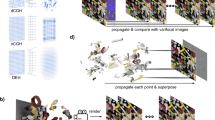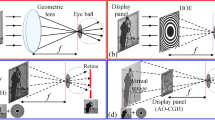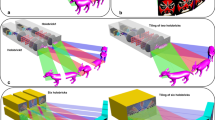Abstract
Projecting high-quality three-dimensional (3D) scenes via computer-generated holography is a sought-after goal for virtual and augmented reality, human–computer interaction and interactive learning. Three-dimensional objects are usually constructed from a single hologram by cascading a stack of two-dimensional (2D) scenes along the optical path and perpendicular to it. The spatial separation between those scenes, however, is fundamentally constrained by the numerical aperture of the hologram, limiting the axial resolution and depth perception of the generated 3D image. Here we propose a new class of hologram that instead projects a desired scene onto 2D sheets oriented perpendicular to the plane of the display screen, thus enabling continuous reconstruction of the object along the optical path. To achieve this, we decompose the target scene into threads of light—arrays of non-diffracting pencil-like beams whose envelopes can be locally structured along the propagation direction at will. Using a spatial light modulator, we project 2D scenes onto the plane normal to the hologram and by stacking multiple 2D sheets in parallel we construct 3D objects with high fidelity and low crosstalk. Computer-generated holography of this kind opens new routes to realistic 3D holography and can be deployed in wearable smart glasses, portable devices and wide-angle volumetric displays.
This is a preview of subscription content, access via your institution
Access options
Access Nature and 54 other Nature Portfolio journals
Get Nature+, our best-value online-access subscription
$29.99 / 30 days
cancel any time
Subscribe to this journal
Receive 12 print issues and online access
$209.00 per year
only $17.42 per issue
Buy this article
- Purchase on Springer Link
- Instant access to full article PDF
Prices may be subject to local taxes which are calculated during checkout




Similar content being viewed by others
Data availability
All key data that support the findings of this study are included in the article and its Supplementary Information. Additional datasets and raw measurements are available from the corresponding authors upon reasonable request.
References
Sheridan, J. T. et al. Roadmap on holography. J. Optics 22, 123002 (2020).
Gabor, D. A new microscopic principle. Nature 161, 777–778 (1948).
Blanche, P.-A. et al. Holographic three-dimensional telepresence using large-area photorefractive polymer. Nature 468, 80–83 (2010).
Heanue, J. F., Bashaw, M. C. & Hesselink, L. Volume holographic storage and retrieval of digital data. Science 265, 749–752 (1994).
Pégard, N. C. & Fleischer, J. W. Optimizing holographic data storage using a fractional Fourier transform. Opt. Lett. 36, 2551–2553 (2011).
Schilling, B. W. et al. Three-dimensional holographic fluorescence microscopy. Opt. Lett. 22, 1506–1508 (1997).
Kim, M. K. Digital Holographic Microscopy 149–190 (Springer, 2011).
Dickey, F. M. Laser Beam Shaping: Theory and Techniques 2nd edn (CRC, 2014).
Padgett, M. & Bowman, R. Tweezers with a twist. Nat. Photon. 5, 343–348 (2011).
Maimone, A., Georgiou, A. & Kollin, J. S. Holographic near-eye displays for virtual and augmented reality. ACM Trans. Graph. 36, 1–16 (2017).
Kohler, C., Schwab, X. & Osten, W. Optimally tuned spatial light modulators for digital holography. Appl. Opt. 45, 960–967 (2006).
Forbes, A., Dudley, A. & McLaren, M. Creation and detection of optical modes with spatial light modulators. Adv. Opt. Photon. 8, 200–227 (2016).
Ren, Y.-X., Lu, R.-D. & Gong, L. Tailoring light with a digital micromirror device. Ann. Phys. 527, 447–470 (2015).
Lee, B. et al. Wide-angle speckleless DMD holographic display using structured illumination with temporal multiplexing. Opt. Lett. 45, 2148–2151 (2020).
Moerner, W. E., Grunnet-Jepsen, A. & Thompson, C. L. Photorefractive polymers. Annu. Rev. Mater. Sci. 27, 585–623 (1997).
Malek, S. C., Ee, H.-S. & Agarwal, R. Strain multiplexed metasurface holograms on a stretchable substrate. Nano Lett. 17, 3641–3645 (2017).
Genevet, P. & Capasso, F. Holographic optical metasurfaces: a review of current progress. Rep. Progr. Phys. 78, 024401 (2015).
Huang, L., Zhang, S. & Zentgraf, T. Metasurface holography: from fundamentals to applications:. Nanophotonics 7, 1169–1190 (2018).
Cutting, J. E. & Vishton, P. M. in Perception of Space and Motion (eds Epstein, W. & Rogers, S.) 69–117 (Academic, 1995).
Yatagai, T. Stereoscopic approach to 3-D display using computer-generated holograms. Appl. Opt. 15, 2722–2729 (1976).
Tajahuerce, E. & Javidi, B. Encrypting three-dimensional information with digital holography. Appl. Opt. 39, 6595–6601 (2000).
Dorsch, R. G., Lohmann, A. W. & Sinzinger, S. Fresnel ping-pong algorithm for two-plane computer-generated hologram display. Appl. Opt. 33, 869–875 (1994).
Makowski, M., Sypek, M., Kolodziejczyk, A. & Mikula, G. Three-plane phase-only computer hologram generated with iterative Fresnel algorithm. Opt. Eng. 44, 125805 (2005).
Mishina, T., Okui, M. & Okano, F. Calculation of holograms from elemental images captured by integral photography. Appl. Opt. 45, 4026–4036 (2006).
Wakunami, K., Yamaguchi, M. & Javidi, B. High-resolution three-dimensional holographic display using dense ray sampling from integral imaging. Opt. Lett. 37, 5103–5105 (2012).
Yamaguchi, M., Hoshino, H., Honda, T. & Ohyama, N. in Practical Holography VII: Imaging and Materials Vol. 1914 (ed. Benton, S. A.) 25–31 (SPIE, 1993).
Barabas, J., Jolly, S., Smalley, D. E. & Bove Jr, V. M. in Practical Holography XXV: Materials and Applications Vol. 7957 (ed. Bjelkhagen, H. I.) 13–19 (SPIE, 2011).
Zhang, H., Zhao, Y., Cao, L. & Jin, G. Fully computed holographic stereogram based algorithm for computer-generated holograms with accurate depth cues. Opt. Express 23, 3901–3913 (2015).
Padmanaban, N., Peng, Y. & Wetzstein, G. Holographic near-eye displays based on overlap-add stereograms. ACM Trans. Graph. 38, 1–13 (2019).
Chen, J.-S. & Chu, D. P. Improved layer-based method for rapid hologram generation and real-time interactive holographic display applications. Opt. Express 23, 18143–18155 (2015).
Zhao, Y., Cao, L., Zhang, H., Kong, D. & Jin, G. Accurate calculation of computer-generated holograms using angular-spectrum layer-oriented method. Opt. Express 23, 25440–25449 (2015).
Zhang, J., Pégard, N., Zhong, J., Adesnik, H. & Waller, L. 3D computer-generated holography by non-convex optimization. Optica 4, 1306–1313 (2017).
Wei, Q., Huang, L., Li, X., Liu, J. & Wang, Y. Broadband multiplane holography based on plasmonic metasurface. Adv. Opt. Mater. 5, 1700434 (2017).
Piao, M.-L. et al. Multi-depth three-dimensional image encryption based on the phase retrieval algorithm in the Fresnel and fractional Fourier transform domains. Appl. Opt. 57, 7609–7617 (2018).
Makey, G. et al. Breaking crosstalk limits to dynamic holography using orthogonality of high-dimensional random vectors. Nat. Photon. 13, 251–256 (2019).
Zhou, Y. et al. Multifunctional metaoptics based on bilayer metasurfaces. Light Sci. Appl. 8, 80 (2019).
Zheng, G., Fu, R., Deng, L., Li, G. & Li, Z. On-axis three-dimensional meta-holography enabled with continuous-amplitude modulation of light. Opt. Express 29, 6147–6157 (2021).
Tay, S. et al. An updatable holographic three-dimensional display. Nature 451, 694–698 (2008).
Smalley, D. E. et al. A photophoretic-trap volumetric display. Nature 553, 486–490 (2018).
Hernandez, O. et al. Three-dimensional spatiotemporal focusing of holographic patterns. Nat. Commun. 7, 11928 (2016).
Almeida, E., Bitton, O. & Prior, Y. Nonlinear metamaterials for holography. Nat. Commun. 7, 12533 (2016).
Huang, L. et al. Three-dimensional optical holography using a plasmonic metasurface. Nat. Commun. 4, 2808 (2013).
Yu, H., Lee, K., Park, J. & Park, Y. Ultrahigh-definition dynamic 3D holographic display by active control of volume speckle fields. Nat. Photon. 11, 186–192 (2017).
Makowski, P. L., Kozacki, T., Zdankowski, P. & Zaperty, W. Synthetic aperture Fourier holography for wide-angle holographic display of real scenes. Appl. Opt. 54, 3658–3665 (2015).
Lucente, M. E. Interactive computation of holograms using a look-up table. J. Electron. Imaging 2, 28–34 (1993).
Kim, S.-C. & Kim, E.-S. Fast computation of hologram patterns of a 3D object using run-length encoding and novel look-up table methods. Appl. Opt. 48, 1030–1041 (2009).
Chen, R. H.-Y. & Wilkinson, T. D. Computer generated hologram with geometric occlusion using GPU-accelerated depth buffer rasterization for three-dimensional display. Appl. Opt. 48, 4246–4255 (2009).
Ren, H., Shao, W., Li, Y., Salim, F. & Gu, M. Three-dimensional vectorial holography based on machine learning inverse design. Sci. Adv. 6, eaaz4261 (2020).
Shi, L., Li, B., Kim, C., Kellnhofer, P. & Matusik, W. Towards real-time photorealistic 3D holography with deep neural networks. Nature 591, 234–239 (2021).
Lesem, L. B., Hirsch, P. M. & Jordan, J. A. The kinoform: a new wavefront reconstruction device. IBM J. Res. Dev. 13, 150–155 (1969).
Lee, W. H. Sampled Fourier transform hologram generated by computer. Appl. Opt. 9, 639–643 (1970).
Haddad, W. S. et al. Fourier-transform holographic microscope. Appl. Opt. 31, 4973–4978 (1992).
Alexandrov, S. A., Hillman, T. R., Gutzler, T. & Sampson, D. D. Synthetic aperture Fourier holographic optical microscopy. Phys. Rev. Lett. 97, 168102 (2006).
Zheng, G., Horstmeyer, R. & Yang, C. Wide-field, high-resolution Fourier ptychographic microscopy. Nat. Photon. 7, 739–745 (2013).
Plesniak, W., Pappu, R., Underkoffler, J., Lucente, M. & St.-Hilaire, P. in Holographic Imaging (eds Benton, S. A. & Bove, V. M.) Ch. 19 (Wiley, 2008).
Gülses, A. A. & Jenkins, B. K. Cascaded diffractive optical elements for improved multiplane image reconstruction. Appl. Opt. 52, 3608–3616 (2013).
Jackin, B. J. & Yatagai, T. 360° reconstruction of a 3D object using cylindrical computer generated holography. Appl. Opt. 50, H147–H152 (2011).
Huebschman, M. L., Munjuluri, B. & Garner, H. R. Dynamic holographic 3-D image projection. Opt. Express 11, 437–445 (2003).
Zabels, R., Osmanis, K., Narels, M., Smukulis, R. & Osmanis, I. in Advances in Display Technologies IX Vol. 10942 (eds Lee, J.-H. et al.) 51–61 (SPIE, 2019).
Zamboni-Rached, M. Stationary optical wave fields with arbitrary longitudinal shape by superposing equal frequency Bessel beams: frozen waves. Opt. Express 12, 4001–4006 (2004).
McGloin, D. & Dholakia, K. Bessel beams: diffraction in a new light. Contemp. Phys. 46, 15–28 (2005).
Ambrosio, L. A. Millimeter-structured nondiffracting surface beams. J. Opt. Soc. Am. B 36, 638–645 (2019).
Arrizón, V., Ruiz, U., Carrada, R. & González, L. A. Pixelated phase computer holograms for the accurate encoding of scalar complex fields. J. Opt. Soc. Am. A 24, 3500–3507 (2007).
Dorrah, A. H. & Capasso, F. Tunable structured light with flat optics. Science 376, eabi6860 (2022).
Chen, W. T., Zhu, A. Y. & Capasso, F. Flat optics with dispersion-engineered metasurfaces. Nat. Rev. Mater. 5, 604–620 (2020).
Lim, S. W. D., Park, J.-S., Meretska, M. L., Dorrah, A. H. & Capasso, F. Engineering phase and polarization singularity sheets. Nat. Commun. 12, 4190 (2021).
Park, J., Lee, K. & Park, Y. Ultrathin wide-angle large-area digital 3D holographic display using a non-periodic photon sieve. Nat. Commun. 10, 1304 (2019).
Dorrah, A. H., Rubin, N. A., Zaidi, A., Tamagnone, M. & Capasso, F. Metasurface optics for on-demand polarization transformations along the optical path. Nat. Photon. 15, 287–296 (2021).
Shaltout, A. M., Shalaev, V. M. & Brongersma, M. L. Spatiotemporal light control with active metasurfaces. Science 364, eaat3100 (2019).
Ren, H. et al. Metasurface orbital angular momentum holography. Nat. Commun. 10, 2986 (2019).
Acknowledgements
We thank A. Zaidi, A. Palmieri and M. Greiner, all of Harvard University, as well as M. Ritsche-Marte of the Medical University of Innsbruck for insightful discussions. A.H.D. acknowledges financial support from the Natural Sciences and Engineering Research Council of Canada (NSERC) under award no. PDF-533013-2019. F.C. acknowledges financial support from the Office of Naval Research (ONR) under the MURI programme, grant no. N00014-20-1-2450, and from the Air Force Office of Scientific Research (AFOSR) under grant nos FA9550-21-1-0312 and FA9550-22-1-0243. V.S.d.A. acknowledges financial support from the National Council for Scientific and Technological Development (CNPq) under grant no. 140270/2022-1. M.Z.-R. acknowledges financial support from CNPq under grant no. 306689/2019-7 and from São Paulo Research Foundation (FAPESP) under grant no 2021/15027-8. L.A.A. acknowledges financial support from CNPq under grant no. 309201/2021-7 and from FAPESP under grant nos 2020/05280-5 and 2021/06121-0.
Author information
Authors and Affiliations
Contributions
A.H.D. designed and built the experiment, created the CGHs with input from P.B. and analysed and processed the data. P.B. performed the measurements and acquired and processed the data. V.S.d.A. and J.O.d.S developed the MATLAB simulations of surface frozen waves. M.Z.-R. conceived the frozen wave theory. L.A.A. developed the mathematical formulation of surface frozen waves. F.C. supervised the project. A.H.D., P.B. and F.C. wrote the paper with input from all co-authors.
Corresponding authors
Ethics declarations
Competing interests
The authors have filed a provisional patent application based on this work.
Peer review
Peer review information
Nature Photonics thanks Fatih Ilday, YongKeun Park and the other, anonymous, reviewer(s) for their contribution to the peer review of this work.
Additional information
Publisher’s note Springer Nature remains neutral with regard to jurisdictional claims in published maps and institutional affiliations.
Extended data
Extended Data Fig. 1 Projecting 2D images with Fresnel holography.
Four digits ‘1 2 3 4’ are axially projected along the propagation direction. The longitudinal separation between the image planes is (a) 5 cm, (b) 2.5 cm, (c) 1 cm, and (d) 0.5 cm. The scale bars in (a-d) are 2 mm, 1.5 mm, 1 mm and 0.8 mm, respectively. While cross-talk can be reduced by placing the images further apart (a), the size of the displayed images vary significantly (becoming larger) at longer propagation distances. This magnification can be mitigated by reducing the separation between the images, however, at the expense of more significant cross-talk (d). Here, ϵ depicts the reconstruction error as detailed in Supplementary Note 4.
Extended Data Fig. 2 Projecting 2D images with holographic light sheets.
Four digits ‘1 2 3 4’ are projected in the lateral direction perpendicular to the display. The lateral separation between the images is (a) 3.042 mm, (b) 1.872 mm, (c) 0.936 mm, and (d) 0.468 mm. The horizontal and vertical scale bars are 10 mm and 0.5 mm, respectively. Here, cross-talk (signified by ϵ) can be reduced by placing the images further apart in the lateral direction without affecting the size of the projected images. Furthermore, given their non-diffracting behavior, our holographic light sheets exhibit a relatively smooth profile (with less grainy features) compared to Fresnel-based multi-plane techniques.
Supplementary information
Supplementary Information
Supplementary Figs. 1–14, Notes 1–5 and refs. 1–23.
Animated visualization of volumetric digit (1) projected onto eight holographic sheets and viewed over the full 4π solid angle.
Animated visualization of a hollow sphere composed of eight stacked rings and viewed over the entire 4π solid angle.
Animated visualization of a hollow sphere composed of eight stacked rings while including two planes between the rings, as viewed over the full 4π solid angle.
Rights and permissions
Springer Nature or its licensor (e.g. a society or other partner) holds exclusive rights to this article under a publishing agreement with the author(s) or other rightsholder(s); author self-archiving of the accepted manuscript version of this article is solely governed by the terms of such publishing agreement and applicable law.
About this article
Cite this article
Dorrah, A.H., Bordoloi, P., de Angelis, V.S. et al. Light sheets for continuous-depth holography and three-dimensional volumetric displays. Nat. Photon. 17, 427–434 (2023). https://doi.org/10.1038/s41566-023-01188-y
Received:
Accepted:
Published:
Issue Date:
DOI: https://doi.org/10.1038/s41566-023-01188-y
This article is cited by
-
Liquid lens based holographic camera for real 3D scene hologram acquisition using end-to-end physical model-driven network
Light: Science & Applications (2024)
-
Neural étendue expander for ultra-wide-angle high-fidelity holographic display
Nature Communications (2024)



